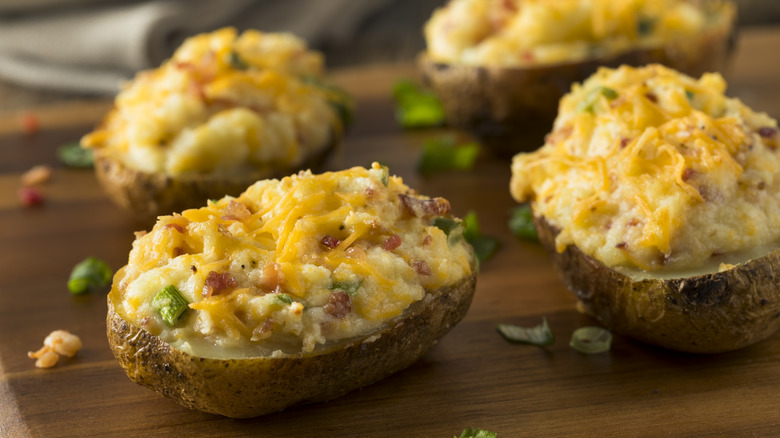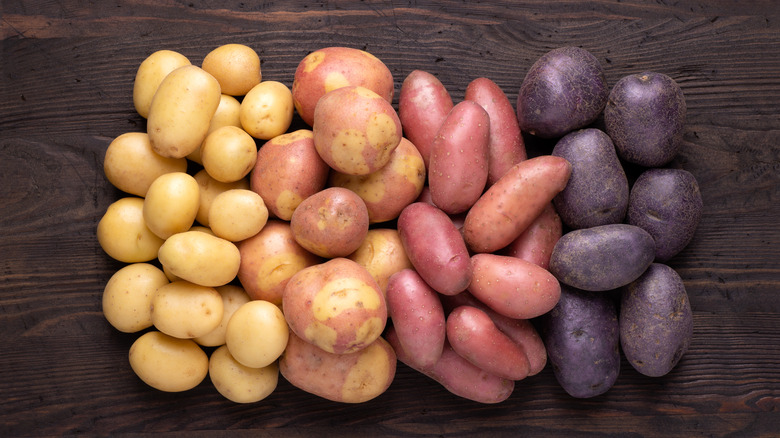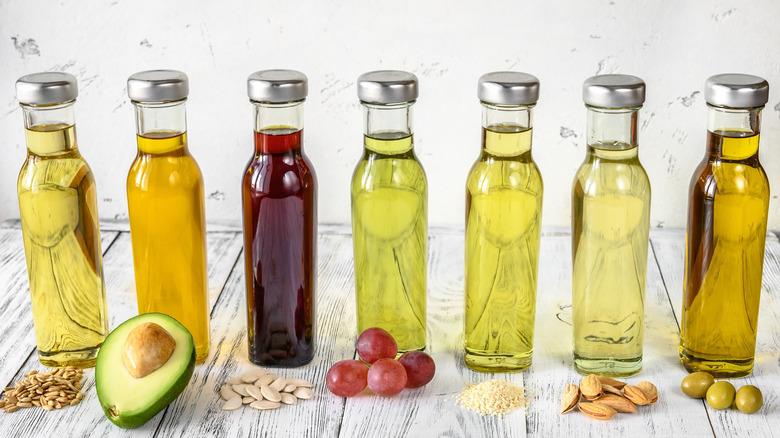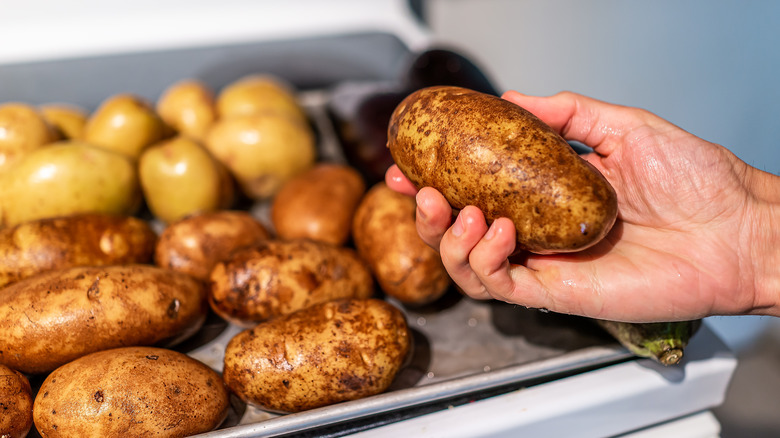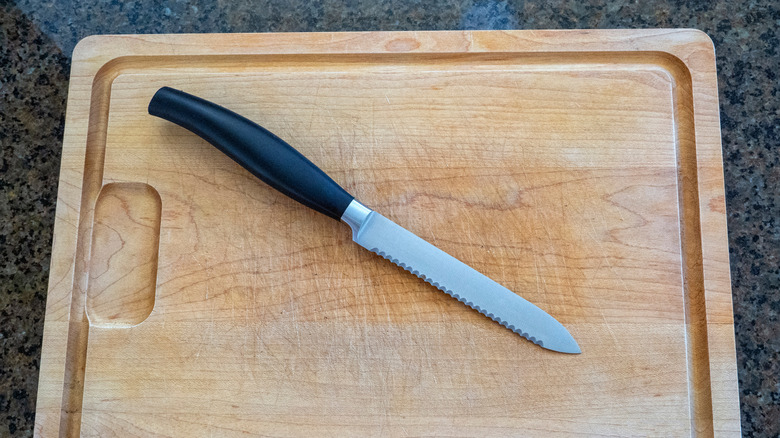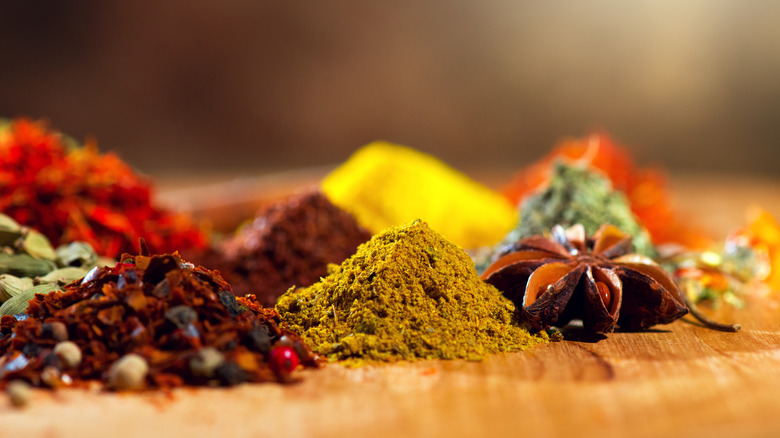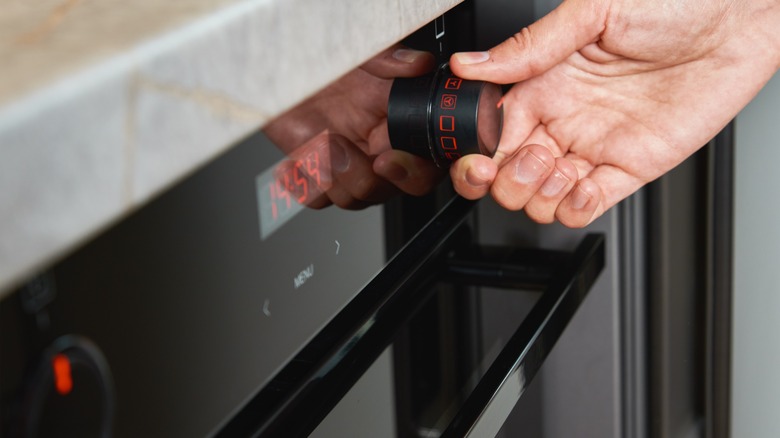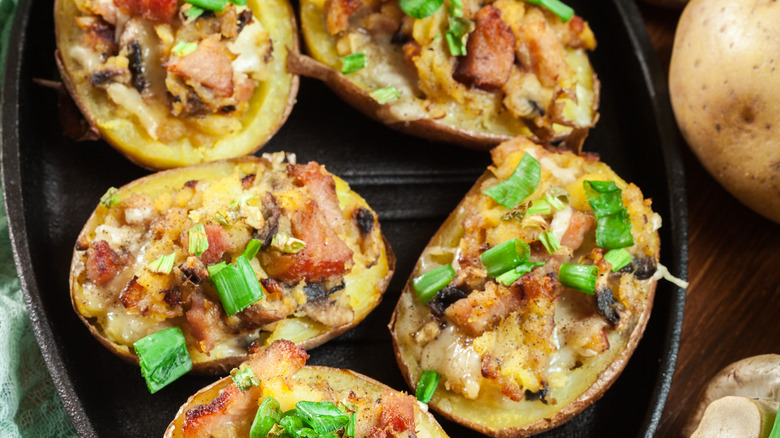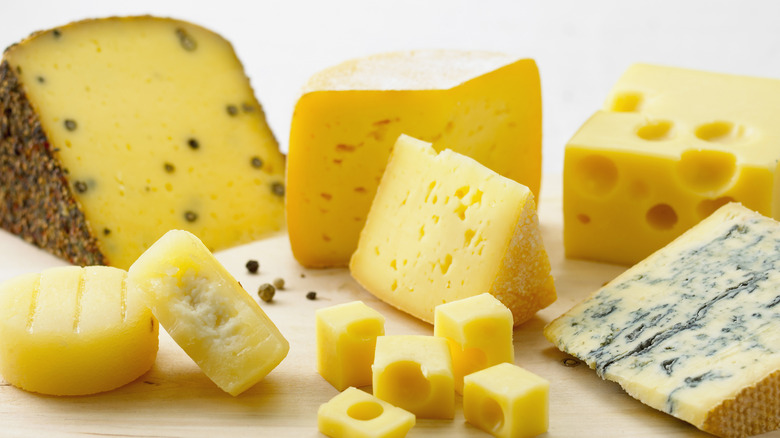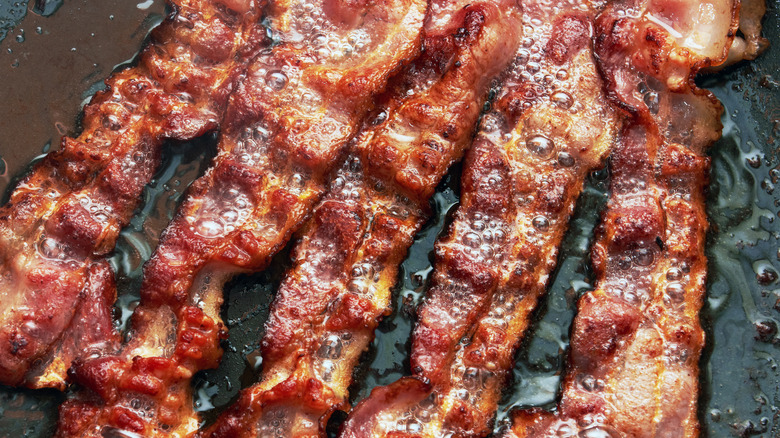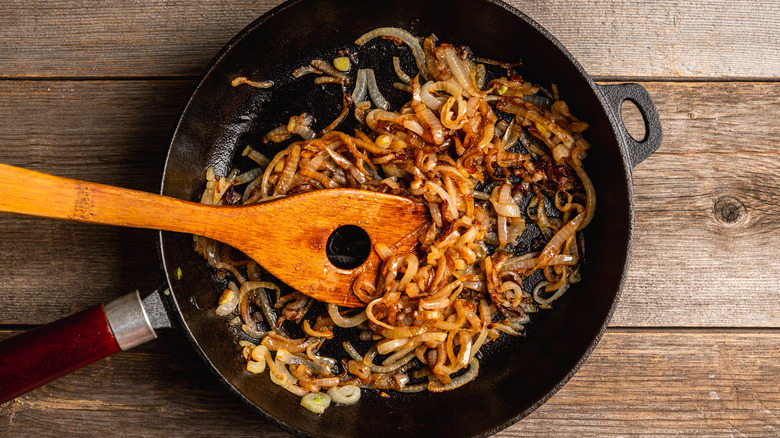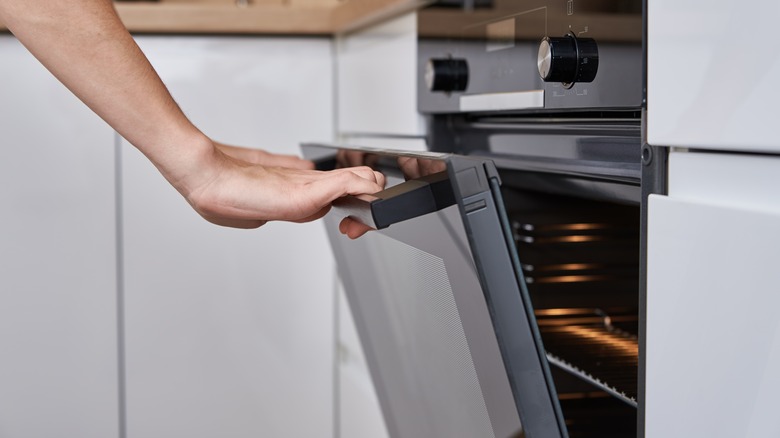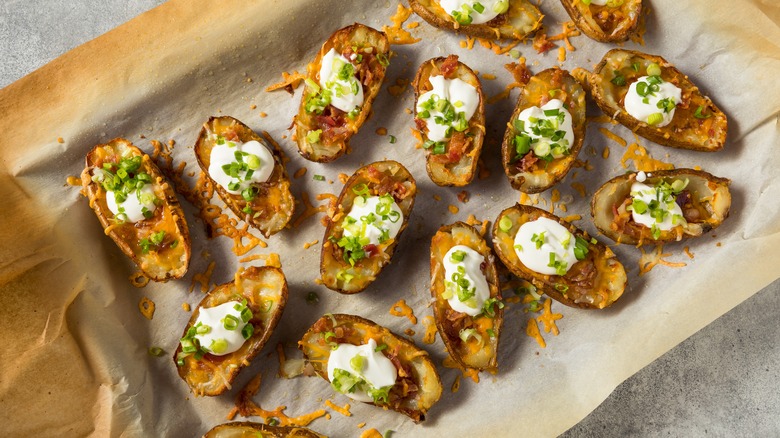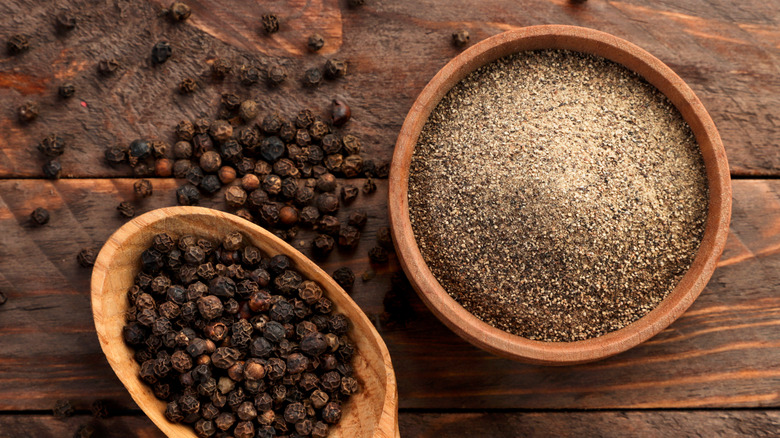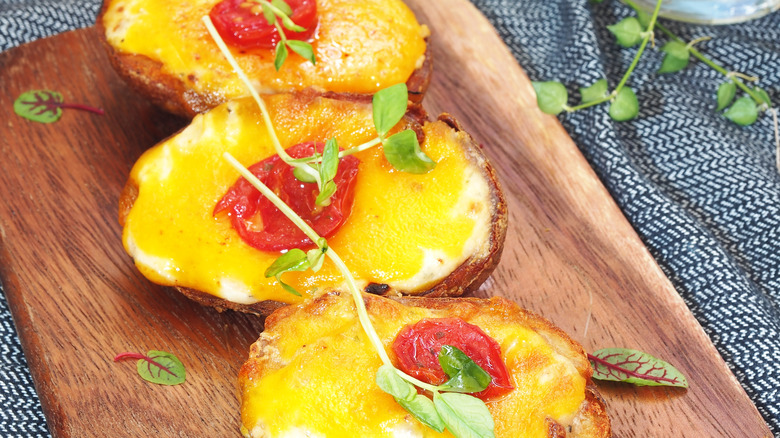14 Tips You Need To Bake Perfect Potato Skins
Ah, the potato. The most universally loved vegetable out there, and it has the ability to go with just about anything. Find fries next to a burger and slaw, or whipped chive mashed potatoes next to a filet mignon with a crimini mushroom whiskey glaze. The options are endless, and while everyone loves a loaded baked potato, there is something extra special about loaded potato skins. Skip the fluff and go right to the fixings. But before you get started, be sure to load up on top tips you need to bake perfect potato skins every time.
There is actually quite a bit of technique involved in achieving that perfect buttery crunch of that starchy skin, coupled with the bubbly brown cheese and crispy meat and veggie bits. Cool it all down with refreshing sour cream, sliced avocado, and, of course, that sprinkling of minced chives. As long as you follow a few consistent rules, then there is quite a bit of wiggle room to experiment with fillings and toppings. And, hey, don't wait until game day to pop these bad boys in the oven! Potato skins are meant to be enjoyed all year round.
Choose the right potatoes
When it comes to potato variety, there are endless options to choose from. Fingerlings, all blue, red bliss, Yukon golds, German butterball potatoes ... the list goes on and on. The potato section of even your local grocer is bound to feature at least four or five varieties, and in markets and farm stands with larger selections, it could be easy to get lost in the variety. They range in color, shape, size, texture, and, of course, flavor.
The best type of potatoes for structurally-sound loaded potato skins has to be our favorite basic variety of Russet. Russet potatoes are those large brown oblong potatoes that you've probably enjoyed baked or roasted quite a few times. They have tougher skin in comparison to most varieties, which helps them to hold their shape when being gutted. The insides are buttery soft, flakey, moist, and bright white. They are large enough to accommodate an abundance of fillings and are mild in flavor so as to not overpower the fixings.
That being said, just because this variety is a classic go-to, feel free to experiment with your favorite variety. Sweet potatoes have a unique taste but are also structurally sound. Just be sure to coordinate the fillings with the potato of choice so that they complement each other.
Oil them up
When it comes to crispy potatoes, it's absolutely essential to start the process off right. Scrub those potatoes to remove any dirt or bacteria that may have clung to the surface with water. It's worth it to use a vegetable brush to reach all of those nooks and crannies, but avoid using any soap. Rinse that spud clean, and poke holes in it using a fork. This will allow air and steam to escape, which can prevent the potato from exploding in the oven. Nobody likes a mess.
Before popping your whole potatoes in the oven, oil them up with fat and seasoning. This is an action item that most people tend to overlook, but it's the first step in creating the crispiest skins. Use a high-temperature baking oil like canola, vegetable, avocado, or safflower oil to rub down your tater. If you'd like, you can opt for animal fat like bacon grease, butter, ghee, lard, duck fat, or beef tallow. If you've never considered them before, animal-based fats can add a layer of depth and flavor to your potato and have the ability to cook at high heat. After your potatoes are covered in your fat of choice, add sea salt and black pepper and rub them into the skin.
Bake your potatoes to perfection
Time to throw those oiled-up taters in the oven! The key to baking a perfect potato with a crispy exterior and fully moist interior is by perfecting the oven temperature and cooking times. Yes, you could pop a potato in the microwave, push the "potato" setting and call it a day. But we can all agree that those zapped potatoes come out rubbery, dry, and wrinkly. There really is no comparison to a true baked potato, so let's start there.
Preheat your oven to 425 degrees Fahrenheit, and once it reaches temperature throw your potatoes straight onto the middle rack or on a lined baking sheet. Let it bake for 50 to 60 minutes, and using long tongs flip it a few times during the baking process. Once it's done, remove it and let it rest. There's a reason people play the game "hot potato," and if nothing else, it's a cautionary tale to never grab one with your bare hands. They retain heat incredibly well and should finish cooking without intervention. Once the potato has cooled, it's time to grab a knife and get cutting. Leave that oven on for further baking in the following steps.
Scoop out just enough of the flesh
Believe it or not, it's crucial that you pick the proper knife for perfectly shaped potato skins. While it might be tempting to grab your sharpest smooth blade, consider opting for an equally sharp serrated knife instead. This will ensure that you don't tear up the skin as you slice the potatoes in half. One of the biggest challenges home cooks run into while preparing potato skins happens during this stage. The potatoes are tender and have a tendency to fall apart if not handled with care. This is why it's essential to use a paring knife to outline the portion of the potato you intend to scoop out, instead of diving in head-first with a spoon.
You'll want to leave at least a quarter inch of flesh to insulate the inside of the skins, or more if you're worried it will fall apart. Remember, you can always remove more, but it can be difficult to add the potato back once it's removed. Take your time and try to be as uniform as possible to avoid burning the edges when rebaking.
Season and oil again
While those potatoes are baking in the oven, it might be time to start whipping up a pan of bacon. For those who eat meat, this is not only the perfect potato skin topping, but it also produces a flavorful salty grease that can be used to coat the inside of the newly formed hallowed skins. For those watching their cholesterol or abstaining from meat, choose a high-temperature oil instead. Mix your fat of choice with sea salt, black pepper, paprika, garlic powder, and onion powder. Adding salt to your potatoes while they are still hot will ensure it penetrates the surface and flavors deep down into the skin.
Brush this flavored oil right into the fleshy surface area of the skin. Most recipes will just suggest coating with unseasoned oil, but potato skins fans and elite cooks know that it's all about the flavorings when it comes to cooking with potatoes. Because of their mild taste, they make the perfect vehicle for flavor. Get creative and choose your own spices to add — just be sure they will complement the fillings you intend to use.
Bake until crispy
Throw those skins back into the oven and cook them until they are golden brown. Keep a close eye on them, as the potato skins are thin and likely to burn much quicker than a full potato. Your goal here is not to dry out the skins, but rather to create a crispy seal so that your little potato boat can carry as much cargo as possible. When the fat interacts with the heat, it helps to crisp up the flesh of the potato because it not only increases the temperature heat but also dries the area.
For those of you with air fryers, this might be a great opportunity to use and it gets those skins extra crispy. Just be sure to handle them with care, and only cook a few at a time to prevent damage to them. Although it might not be worth the hassle to transfer the skins back and forth from the oven to the air fryer, air fryer fans know that the crispy crunch that you can get from those magical machines is just about as close as you can get to a deep fryer without all of the health risks.
Choose a theme
Choosing which ingredients to add to potato skins is all about planning and setting up a theme. Remember, each item that goes into the skin at this stage will go through one more round of baking, so only choose items that are meant to be heated. Avoid fresh herbs and cool toppings at this stage.
If you've chosen the traditional route, consider using cheddar cheese, bacon, and broccoli. But if you're ready to experiment, this is the stage where you'll want to consider what ingredients go together. Beyond traditional flavorings, you could choose a region of the world where you enjoy the food. For instance, if you love Italian food, think about using marinara sauce, mozzarella cheese, and pepperoni slices, and add a little roasted red pepper, garlic, and caramelized onion. For a Greek theme, consider feta cheese, sliced cherry tomatoes, pesto, pine nuts, and kale. If you've used a sweet potato, go full hippie and add roasted chickpeas, spinach, and shaved roasted Brussels sprouts. Who says you have to stick to the basics?
Select the right cheese
Depending on your theme, it's important to take your time in selecting the right cheese. Now, when it comes to the world of cheese, every monger knows that there are endless possibilities. Besides a few basic guidelines, you're free to go in any direction you see fit. Consider using a medium to soft cheese to encourage melting. Mild cheeses work best unless they are the feature of the potato skin dish. Cheddar is often used in traditional potato skins because of its sharp flavor, melt-ability, and ability to pair flawlessly with the other ingredients.
Consider trying a milder cheese like mozzarella or gouda to pair with vegetables and salty meats. Include strong cheese like blue cheese or gorgonzola to pair with buffalo chicken, dark leafy greens, or chestnut mushrooms. If you're opting for dairy-free potato skins, consider sprinkling those skins with a bit of nutritional yeast. It has a nippy cheese-like flavor but will not melt like cheese. Cashew cream can also be used as a substitute for mild cheese, and will even brown slightly in the oven. Heck, you can even use a unique cheese recommended by your local deli and don't forget to ask them about pairing options.
Pre-cook any meats
Meat and cheese are typically stapes when it comes to potato skin basics. Although it's quite possible to make drool-worthy vegan potato skins, if you do choose to use meat, there are a few important rules to cook by for ultimate texture and flavor.
It's important to pre-cook any meats you intend to use before adding them to your potato skins. This is not only a safety precaution, but it's easier to reach the perfect texture in a pan rather than hoping to time the cooking of your meat with the melting of your cheese.
We recommend using bacon, because not only can you crumble the crunchy, crispy, fatty bits on top of your potato skin, but in addition, you can use the leftover bacon grease as your fat when rebaking the skins. For other meats like shredded chicken, ground beef, and seafood, remember to season and cook them thoroughly before adding them to your potato boat.
Add vegetables
While meat can add a salty and crispy element to potato skins, it's important to find balance. Cooked vegetables can become quite sweet and can help to break up the dense, heavy mouthfeel of oiled potatoes, meat, and cheese.
A universal favorite when it comes to potato skins is to add roasted broccoli. Any cruciferous vegetable will add a similar texture and flavor, but there is something so classic about those little green florets. Another safe bet is caramelized onions. There's no arguing that these sweet tender veggies pair flawlessly with potatoes and can only enhance the skins.
Adding finely chopped and cooked kale is another way to break up the heavy texture of the skins. Be sure to sauté them with a little garlic powder, sea salt, or tamari in order to help them shine. If you're not a fan of green vegetables, try adding roasted red peppers or raw red peppers that will soften in the oven. Swap meat and add beans instead for a hearty and filling alternative. White beans work well in Mediterranean-themed skins, and black beans work best for Mexican-style skins.
Bake again to perfection
Be sure to load those skins up quickly to eliminate the possibility that they will dry out between bakings. Once your "hot" ingredients have been added to your tuber boats, it's time to throw the whole mess back into the oven. Yes, for a third and final time. While it may seem like these little skins live in there, each step is important for achieving perfect potato skins, and it's so worth it. The purpose of this step is mostly to melt the cheese and reheat any ingredients that have cooled off after cooking.
Keep a close eye on those skins, and leave them in long enough for that cheese to bubble. If you prefer your cheese to brown, leave it in a little longer, but take caution that your vegetables and the edges of the potatoes don't burn. Softer cheeses like brie and gorgonzola will melt more quickly, and hard cheeses like Parmesan and manchego will take quite a bit longer.
Garnish with fresh ingredients
Is there anything more exciting than loading up at a toppings bar? Whether it's for nachos, chili, tacos, or potato skins, one thing is guaranteed: You won't be at a loss for flavor. Just because your potato skins are already loaded to the brim with bubbling cheese, chewy meat, roasted veggies, and seasoning doesn't mean the party has to end there. Fresh ingredients are essential to creating a balanced mouthfeel. So far, we've been dealing with greasy, salty, hot foods so the contrast of crisp, cool, light toppings can be quite refreshing and add variety.
It's important to include a plethora of toppings. Add diced raw vegetables like tomatoes, sweet onion, crunchy bell peppers, spicy jalapeños, and creamy avocado. Next, choose sauces like sour cream, chipotle aioli, ranch dressing, or whisked tahini. Salsa and guacamole complement a Mexican-themed potato skin flawlessly. Lastly, don't skimp on fresh herbs. Minced cilantro, green onion, parsley, and chives are not only beautiful garnishes but will give those potatoes some extra flavor and pizzazz.
You can never have too much seasoning
When it comes to toppings, the fun is not over yet. Just because you seasoned your potato in the beginning doesn't mean you can throw those spices back into the cabinet. At the very least, top your loaded spuds with coarsely ground black pepper to give them some texture and spice. If you've dolloped on the sour cream or whipped feta, then it's time to break out the brilliant red paprika for a dusting.
For those who love steam coming out of their ears, try drizzling a little sriracha, buffalo sauce, or chili sauce right onto the toppings. Cayenne pepper or chili flakes can give your dish just the right amount of heat, but be cautious not to overpower the natural flavors of the fillings. You can also dust those stuffed skins with garlic powder. This step is often skipped by home cooks, but it is one of the top tips you need to bake perfect potato skins.
Get creative
While these top tips have set you up for successfully baked potato skins, it's important to understand the importance of creative liberty when dabbling in the culinary arts. Just because we've mentioned that russet potatoes hold up the best, or that broccoli and cheddar complement potatoes well, that doesn't mean you have to limit yourself. Thankfully, potatoes are one of the most versatile foods out there. What other food is equally loved mashed, fried, baked, whipped, blended into soup, shredded, or dehydrated into flakes? Enjoy them for breakfast, lunch, and dinner.
You see our point. Because of their mild flavor, we encourage you to think outside of the box and add your own flair. If you love African peanut stew, consider using sweet potato skins and stuffing them with roasted tomatoes, onions, garlic, carrots, chickpeas, and peanut butter, topped with crunchy peanuts and green onion. If you can't get enough Korean cuisine, try potato skins with pork belly and kimchi. Even if it doesn't fall into a specific type of cuisine, think about dishes you've enjoyed. How about breakfast skins with scrambled eggs, bacon, and cheddar cheese? Or sweet skins with sweet potatoes, cinnamon, butter, and marshmallows? Now let's get cooking.
